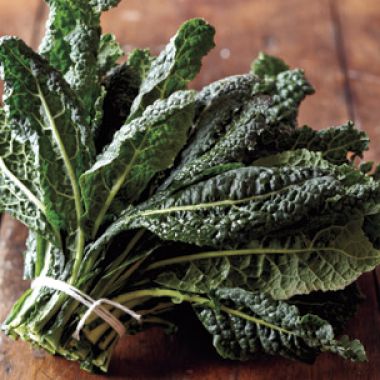
Kale, a member of the cabbage family, has firm, tightly crinkled leaves on long stems. The green, sturdy leaves have an earthy flavor similar to cabbage and keep their texture well when cooked. Italian varieties have narrower, more tapered leaves, while dinosaur kale (also called cavolo nero) can be recognized by its dark green color.
Kale is available at local farmers’ markets during the autumn and winter. Like other dark, sturdy greens, it can be highlighted in soups and sauces, braised or sautéed as a side dish, chopped finely into fillings, and stirred into starchy accompaniments.
Selecting
In kale bunches, look for dark green color
and crisp, large, spreading leaves. Leaf shape and size will vary by type. Avoid any bunches that have brown or yellow leaves, or ribs that are dry or wilted enough to bend.
Storing
Store in a plastic bag in the refrigerator for up to 5 days.
Preparing
Wash kale as you would spinach: fill a large bowl with cold water, immerse the leaves, and then lift them out, letting the grit settle at the bottom. Repeat with fresh water until completely free of grit. Spin dry in a salad spinner. If the stems are fibrous, use a paring knife to cut them away, along with the tough center vein that runs along the center of each leaf. Discard the veins. Cut and cook the stems separately from the leaves, as they will take longer to become tender. Sautéed or simmered, stem pieces will take 5 to 10 minutes to cook.
Adapted from Williams-Sonoma Cooking from the Farmers’ Market, by Tasha DeSerio & Jodi Liano (Weldon Owen, 2010).
Related Recipes:
- Crostini with White Beans, Garlic and Tuscan Kale →
- Kale Salad with Pine Nuts, Currants and Parmesan →
- Shredded Kale Salad with Pancetta and Hard-Cooked Egg →
- Chicken Soup with Kale →
- Kale and Good Mother Stallard Bean Stew →
- Colcannon →
- Baked Chicken Parmesan →
- Tuscan Ribollita →
- Carrot and Kale Juice →












